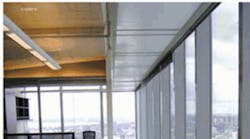The quest to improve the energy efficiency of building HVAC systems has led to the increased adoption of chilled beams as a design strategy for controlling perimeter zones, and sometimes interior zones, of buildings. With an active chilled beam, water pipes carry chilled and hot water to a coil mounted within the device, which then cools or heats the air delivered to a space. The energy efficiency and high capacity of water cooling and heating, coupled with the ability to condition perimeter loads before they affect building occupants, have been strong catalysts in chilled beams’ growth in popularity.
In-floor chilled beams represent a new alternative to traditional ceiling-mounted beams. In-floor chilled beams offer capacity and efficiency similar to ceiling-mounted chilled beams, while providing additional benefits and addressing some of the negative traits associated with overhead chilled beams. In-floor chilled beams are installed in a raised-floor system at the perimeter of a building and are designed to work in conjunction with the pressurized plenum of an underfloor-air-distribution (UFAD) system.
In-floor Active Chilled Beams
In-floor active chilled beams function differently than overhead active chilled beams. Overhead chilled beams induce space air in cooling mode by creating induction of warm space air across a coil. In heating mode, these units typically experience limited induction and capacity becuase of natural-convection air patterns in a space.
Underfloor chilled beams only entrain space air during heating operation. The intent is to maximize the efficiency of heating by utilizing the natural convection in a space while minimizing concerns regarding condensation when entraining unconditioned air across a chilled-water coil. Located directly under a building’s perimeter glass, the beam catches cold air as it falls, heats it, and supplies it back to the space, saving energy and providing maximum heating performance.
In cooling mode, in-floor active chilled beams use only preconditioned air supplied from the pressurized underfloor plenum through an automatic damper.
By bringing chilled water to the perimeter of a space under a raised floor and supplying it with preconditioned primary air, one should have little concern about damage from leaking water lines and latent loads producing condensate.
In-floor active chilled beams are designed to provide a high-capacity cooling or heating solution to the perimeter of an office space to handle the facade loading that typically drives the total HVAC requirements for a building design. By accomplishing conditioning with a perimeter hydronic solution, rather than an all-air solution, the volume of air required to meet the perimeter’s conditioning needs can be minimized while ventilation requirements still are met. Minimizing air volume creates the potential to downsize central or multiple-zone air handlers or eliminate fan-powered terminals often used to supply the perimeter zone of a UFAD system. Lower air volumes also can help to lower the finished floor height of a design. All of these can contribute to significant reductions in energy and maintenance costs throughout the life of a building.
Overhead active chilled beams often require extensive ductwork to meet the ventilation requirements of a space while reaching the perimeter of an office with preconditioned ventilation air. However, in-floor chilled beams require little or no ductwork, as the UFAD system provides a simple location to provide primary air supply. UFAD systems also help to improve efficiency, ventilation effectiveness, and personal comfort control.
Configuring a System
Chilled beams are available in a number of configurations. A two-pipe hydronic configuration utilizes a system changeover selected by the building operator and takes advantage of the conditioned underfloor air plenum to cool with air when chilled water is not yet available in the shoulder seasons. A four-pipe configuration is designed to maximize control and efficiency by utilizing either chilled-water or hot-water loops when necessary to meet the conditioning needs of a building. A two-pipe electric configuration is available for use in warmer climates where the controllability and flexibility of a four-pipe configuration is desired, but heating is less frequently required, making hot water less cost-effective. In colder climates, active radiant coils, which are designed to provide only heating during winter and cool with primary air only during summer, are available.
While the type of chilled beam can be determined in respect to the operation and climate of a project, in-floor chilled beams typically are sized in accordance with a building’s skin load, taking into account the facade adjacent to the units and the ventilation air required. Length and spacing between units are similarly determined in respect to skin load.
Figure 1 provides heating and cooling capacities per linear foot for in-floor active chilled beams based on several fixed parameters. Chilled beams can be available in both typical-density (TD) and high-density (HD) designs. These options reflect the ability to achieve a greater capacity by increasing the airflow of the device.
Advantages of a UFAD System
A UFAD system uses a raised floor to create an air-distribution plenum that improves energy efficiency and modularity of design. The system supplies air at floor level, using the space between the raised-floor panels and the building slab as a low-pressure plenum, nearly eliminating ductwork. By removing a large portion of the branch and supply ductwork, the overall system pressure can be reduced significantly, saving fan energy.
UFAD uses stratified airflow to improve the ventilation effectiveness and indoor-air quality of an interior space. Stratified airflow refers to the delivery of air at a low velocity near the floor, allowing the air to naturally rise to a ceiling return, pulling contaminants and carbon dioxide away from occupants.
Page 2 of 2
UFAD systems also improve flexibility and control. UFAD allows for easy diffuser reconfiguration in reaction to office occupancy and layout changes. Because the diffusers tap directly into the air-delivery stream, they can be removed easily and relocated without moving ductwork. Each diffuser can be equipped with personal comfort controls so that occupants can adjust the amount and direction of airflow in their space.
Another advantage of UFAD is the increased opportunity to provide occupants with daylighting and access to views. The space needed for service distribution in an underfloor system is reduced significantly when compared with the requirements of an overhead system. This reduction in service distribution space can allow building designers to expand floor-to-ceiling space and increase overall window heights. The large capacity of in-floor chilled beams is capable of handling the added solar load associated with expanded windows before it affects the occupants.
How In-Floor Active Chilled Beams Improve UFAD
Overall, placing a chilled beam at the perimeter of a building can simplify the design of a UFAD system by eliminating concerns about thermal decay. Typical UFAD designs use spider ducting to deliver air within 50 ft of the perimeter so it can be delivered to the space before it warms under the floor. The in-floor active chilled beam solves this by bringing chilled water to cool air directly at the perimeter of a building. Using chilled beams in place of perimeter fan-powered boxes under the raised floor allows furniture and partitions to be placed freely in a building without concern for the maintenance access ability of equipment.
Many perimeter solutions for raised-floor applications available today are limited aesthetically, requiring numerous haphazardly placed diffusers throughout the perimeter area. The in-floor active chilled beam reduces the quantity of visible diffusers within the perimeter zone and creates a cleaner appearance. With a 6-in.-wide segmented or continuous linear grille used along the perimeter of a building, an in-floor chilled beam seamlessly integrates into the design of a space.
Conclusion
In-floor active chilled beams address the challenges of perimeter heating and cooling in a new way, providing all the benefits and savings of an overhead chilled beam, but without the threat of damage from condensation or leaking water lines. By working with a UFAD system, an in-floor chilled beam delivers chilled water to the perimeter space of a building for high energy efficiency and good overall building performance. At the same time, it takes advantage of the underfloor plenum to ensure few equipment and ductwork requirements, easy access for maintenance, tight control over personal comfort, and good indoor-air quality. Additionally, in-floor active chilled beams reduce the quantity of visible diffusers within the perimeter zone and create a clean appearance. In short, this innovation in commercial construction offers designers an energy-saving solution that takes advantage of the proven technologies of UFAD to create a comfortable, attractive perimeter space.
Peter Strapp is senior product-development engineer for Tate Inc. He is a graduate of Virginia Polytechnic Institute and Virginia State University and holds a bachelor’s degree in mechanical engineering and a minor in industrial design. He is a member of the Center for the Built Environment and ASHRAE and is an active participant in ASHRAE Technical Resource Group 7, Underfloor Air Distribution. He can be reached at [email protected].
Did you find this article useful? Send comments and suggestions to Senior Editor Ron Rajecki at [email protected].









